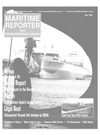
Lubes Keep Step With Diesel Development
Marine diesels are constantly evolving, with today's 12-cylinder monsters already weighing 2,000 tons and developing as much as 93,000 hp. Tomorrow's propulsion units are going to be even bigger and more powerful and will need highperformance lubricants to match.
Today's ocean-going vessels are driven by two main types of engine, both operating on heavy fuel oil: medium-speed (300-1,000 rpm) and low-speed (60-300 rpm) engines.
Medium-Speed Engines Medium-speed engines use a trunkpiston design where the connecting rod is linked directly to the piston, and they are connected to the propeller via reduction gearing. Their power rating can go as high as 2,010 kW per cylinder, with up to 18 cylinders in V-configuration. The largest bore used is 640 mm and the stroke/bore ratio can be as high as 1.4 maximum combustion pressure reaches 180 bar for a mep of 25 or 26 bar.
The leading designer-builders are MAN B&W, Wartsila Corp. and Caterpillar, with engines also built under license by other firms all over the world.
Low-Speed Engines The basic structure of low-speed engines is different to medium-speed units, with the cylinder section of the engine separate from the crankshaft section. Low-speed engines use direct drive to the propeller and can develop up to 5,710 kW per cylinder, with as many as 12 cylinders. The largest bore used is 980 mm, the stroke/bore ratio can be as high as 3.8 and rotation speed can go as low as 60 rpm. Maximum pressure reaches 150 bar for a mep of 19 bar. Three designers dominate the market, MAN B&W, Wartsila Corp. and Mitsubishi Heavy Industries, with the first two having 90 percent of the market in terms of installed power.
Circle 4 4 on Reader Service Card www.maritimereporterinfo.com The preceding was excerpted from Lubmarine News, No.6.
Other stories from May 2002 issue
Content
- Delta Queen Makes A Comeback page: 3
- USS Cole Returns to Fleet page: 4
- Polar Discovery Christened at Avondale page: 7
- Heidenreich Marine Reorganizes Companies page: 8
- Transas Breaks Through Visual Technology page: 8
- Navibulgar Finalizes Varna Shipyard Deal page: 9
- Horbeck-Leevac To Build Eight OSV's page: 9
- Navibulgar Initiates Fleet Renewal Program page: 9
- OSHA Standards Applicable on Uninspected Vessels page: 10
- Munson Delivers PACKCAT to U.S. Navy page: 11
- U.S. Navy Awards Northrop Grumman $ 1 . 3 B LHD Contract page: 11
- Shipboard Life in Style page: 12
- Has the Fast Cat Come to A Halt? page: 15
- Market Changes Mold RoRo Ship Conversions page: 16
- Seville Delivers RoPax Ferry page: 18
- Crankshaft Care Key to Vessel Profitability page: 19
- AIS:When & Where? Here & Now! page: 20
- Crowley Subsidiary Christens ATB page: 24
- Ballast Water Treatment Through Biodispersion page: 26
- LNG Breakthrough For Wartsila page: 29
- New Measures on Ballast Water Management Approval page: 32
- The GMD Group - A Young, Ambitious Team page: 33
- Seven Seas Mariner Undergoes Pod Adjustment page: 34
- Teekay Foam's Discharge Pipe Repaired in Bilbao page: 36
- Government Ships Spend Time At Cascade page: 38
- ASRY Continues Brisk Repair Pace page: 39
- FRP Pumps Offer Lasting Results page: 40
- Spray-On Insulation Cuts Maintenance Costs page: 42
- SEI Temp-Set Reusable Insulation Covers page: 42
- EU to Develop Sulfur Strategy page: 43
- CITGO Offers "No Sheen" Aquamarine Oils page: 43
- Good Fuel = Good Profits page: 44
- Lubes Keep Step With Diesel Development page: 44
- Jeamar's Winches Are Made To Order page: 45
- Victoria Shipyard Racks Up Cruise Ship Jobs page: 45
- Targeting Greek Shipping's $16B Budget page: 46
- Elefsis Helps Speed LNG Retrofit page: 47
- Stelmar Set To Expand Fleet, Receives Tanker page: 51
- HHI: To Infinity & Beyond page: 52
- Dual-Fuel Finds A New Backer page: 57
- U.S. Navy Selects Gold Team For DD(X) page: 57
- Packing Solutions Help Bear Set Sail page: 57

